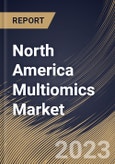In the rapidly evolving landscape of life sciences and biomedical research, multiomics is emerging as a transformative approach with profound implications for understanding human biology, disease mechanisms, and personalized healthcare. It is a groundbreaking discipline that integrates and analyzes multiple layers of biological data at the molecular level. Combining genomics, transcriptomics, proteomics, metabolomics, and other "omics" disciplines offers a holistic view of complex biological systems, enabling comprehensive insights into health and disease.
Multiomics data integration has revolutionized cancer research by identifying critical driver mutations, unravelling tumour heterogeneity, and discovering potential biomarkers for early diagnosis and targeted therapies. It has allowed for a deeper understanding of host-pathogen interactions in infectious diseases, aiding in developing vaccines and therapeutics. Multiomics data facilitates the identification of novel drug targets, enabling the pharmaceutical industry to develop more effective and specific therapies.
Multiomics data integration allows researchers to pinpoint critical driver mutations responsible for the initiation and progression of cancer. By examining cancer cells' genomic and transcriptomic profiles, scientists can identify genetic alterations that drive oncogenesis. This knowledge is invaluable for developing targeted therapies that specifically inhibit the action of these mutations. For example, identifying specific mutations in genes like EGFR (Epidermal Growth Factor Receptor) in non-small cell lung cancer (NSCLC) has led to targeted therapies like gefitinib and erlotinib.
The healthcare sector in Canada is a major focus of biotechnology. The country is home to numerous biopharmaceutical companies involved in drug discovery, development, and manufacturing. Research institutions and universities conduct cutting-edge research in genomics, proteomics, and personalized medicine. According to the Government of Manitoba data, as the leading pharmaceutical manufacturing center in Western Canada, Manitoba is a hub for life sciences and biotechnology. Manitoba is Canada's second-largest province for pharmaceutical and medicine manufacturing, with $5.4 billion in exports (2022). Thus, the rising biotechnology sector in countries like the United States and Canada will enhance its demand in the North America region.
The US market dominated the North America Multiomics Market by Country in 2022, and would continue to be a dominant market till 2030; thereby, achieving a market value of $1,871.3 million by 2030. The Canada market is experiencing a CAGR of 17% during (2023 - 2030). Additionally, The Mexico market would register a CAGR of 16% during (2023 - 2030).
Based on Type, the market is segmented into Bulk Multiomics, and Single-cell Multiomics. Based on Product & Service, the market is segmented into Product (Instruments, Consumables, and Software), and Services. Based on End-use, the market is segmented into Academic & Research Institutes, Pharmaceutical & Biotechnology Companies, and Others. Based on Platform, the market is segmented into Genomics, Transcriptomics, Proteomics, Metabolomics, and Integrated Omics Platforms. Based on Application, the market is segmented into Cell Biology, Oncology, Neurology, and Immunology. Based on countries, the market is segmented into U.S., Mexico, Canada, and Rest of North America.
The market research report covers the analysis of key stake holders of the market. Key companies profiled in the report include Thermo Fisher Scientific, Inc, Illumina, Inc., Danaher Corporation, PerkinElmer, Inc., Bruker Corporation, Qiagen N.V., Agilent Technologies, Inc., BGI Group, Becton, Dickinson, and Company, Shimadzu Corporation.
Scope of the Study
Market Segments Covered in the Report:
By Type- Bulk Multiomics
- Single-cell Multiomics
- Product
- Instruments
- Consumables
- Software
- Services
- Academic & Research Institutes
- Pharmaceutical & Biotechnology Companies
- Others
- Genomics
- Transcriptomics
- Proteomics
- Metabolomics
- Integrated Omics Platforms
- Cell Biology
- Oncology
- Neurology
- Immunology
- US
- Canada
- Mexico
- Rest of North America
Key Market Players
List of Companies Profiled in the Report:
- Thermo Fisher Scientific, Inc
- Illumina, Inc.
- Danaher Corporation
- PerkinElmer, Inc.
- Bruker Corporation
- Qiagen N.V.
- Agilent Technologies, Inc.
- BGI Group
- Becton, Dickinson, and Company
- Shimadzu Corporation
Unique Offerings
- Exhaustive coverage
- The highest number of Market tables and figures
- Subscription-based model available
- Guaranteed best price
- Assured post sales research support with 10% customization free
Table of Contents
Companies Mentioned
- Thermo Fisher Scientific, Inc
- Illumina, Inc.
- Danaher Corporation
- PerkinElmer, Inc.
- Bruker Corporation
- Qiagen N.V.
- Agilent Technologies, Inc.
- BGI Group
- Becton, Dickinson, and Company
- Shimadzu Corporation








